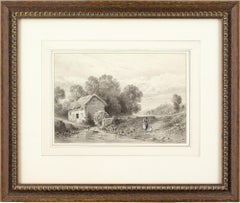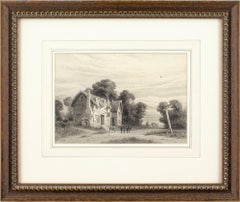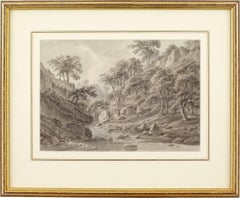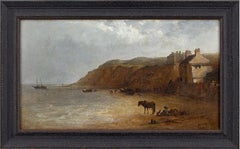Want more images or videos?
Request additional images or videos from the seller
1 of 12
Frederic Lord Leighton (After), The Last Watch Of Hero, Gravurec. 1897
c. 1897
$661.47List Price
About the Item
- Creation Year:c. 1897
- Dimensions:Height: 40.5 in (102.87 cm)Width: 30 in (76.2 cm)
- Medium:
- Movement & Style:
- After:Frederic Leighton (1830 - 1896, British)
- Period:
- Condition:Artwork presents well. Frame with some light wear.
- Gallery Location:Cheltenham, GB
- Reference Number:1stDibs: LU2328211649222
About the Seller
5.0
Gold Seller
Premium sellers maintaining a 4.3+ rating and 24-hour response times
Established in 2017
1stDibs seller since 2023
249 sales on 1stDibs
Typical response time: 2 hours
Authenticity Guarantee
In the unlikely event there’s an issue with an item’s authenticity, contact us within 1 year for a full refund. DetailsMoney-Back Guarantee
If your item is not as described, is damaged in transit, or does not arrive, contact us within 7 days for a full refund. Details24-Hour Cancellation
You have a 24-hour grace period in which to reconsider your purchase, with no questions asked.Vetted Professional Sellers
Our world-class sellers must adhere to strict standards for service and quality, maintaining the integrity of our listings.Price-Match Guarantee
If you find that a seller listed the same item for a lower price elsewhere, we’ll match it.Trusted Global Delivery
Our best-in-class carrier network provides specialized shipping options worldwide, including custom delivery.You May Also Like
The Twin Rocks of Capri; I Faraglioni a Capri
Located in Middletown, NY
London: Gebbie & Husson Co., 1879
Héliogravure and engraving on cream wove paper, 10 1/4 x 12 1/4 inches (258 x 310 mm), full margins. In good condition with some very minor margina...
Category
Late 19th Century English School Landscape Prints
Materials
Engraving, Photogravure
Chartres La Mort de la Viegre X111”
Located in Southampton, NY
Original photo mechanical print handcolored throughout by the French artist, Lucy Garnot. Signed and titled bottom. Circa 1900. Condition is very go...
Category
Early 1900s Academic Figurative Prints
Materials
Archival Paper, Photogravure
Cuban artist original hand signed photo-engraving n6 22x30 in.
Located in Miami, FL
Juan Carlos Alom (Cuba, 1964)
'Tarjetas postales', 2004
photoengraving on paper
22.1 x 30 in. (56 x 76 cm.)
Edition of 99
ID: ALO1534-006
Hand-signed ...
Category
Early 2000s Contemporary Figurative Prints
Materials
Paper, Photogravure, Engraving
$1,500
H 22 in W 30 in
Prêtresse antique (Ancient Priestess)
By Félicien Rops
Located in Middletown, NY
Heliogravure by Félicien Rops (1833 – 1898), a Belgian artist, known primarily as a printmaker in etching and aquatint. He is noted for his drawings depicting erotic and Satanic them...
Category
Late 19th Century Symbolist Nude Prints
Materials
Handmade Paper, Photogravure, Stencil
La Place Saint Georges, Paris
Located in Middletown, NY
London: Gebbie & Husson Co., 1879.
Héliogravure and engraving on cream wove paper, 10 1/4 x 12 1/4 inches (258 x 310 mm), full margins. In good condition with some very minor margin...
Category
Late 19th Century French School Landscape Prints
Materials
Handmade Paper, Engraving, Photogravure
Place de la Concorde, Paris
By Giuseppe De Nittis
Located in Middletown, NY
Paris: Gebbie & Co., 1895.
Photogravure and engraving on cream wove paper, 6 11/16 x 9 5/8 inches (169 x 244 mm), full margins. In good condition with minor toning and three scatter...
Category
Late 19th Century French School Landscape Prints
Materials
Handmade Paper, Engraving, Photogravure
Canal with a large Boat and Bridge – after Rembrandt van Rijn
By Charles Amand Durand
Located in Middletown, NY
Heliogravure on cream laid paper, 3 1/4 x 4 1/4 inches (80 x118 mm), thread margins. In good condition with a soft vertical crease and minor uniform toning. Printed early 19th centur...
Category
17th Century Old Masters Figurative Prints
Materials
Laid Paper, Photogravure
$400
H 3.15 in W 4.65 in
Reclining Woman - Figurative Abstract Series (Set of 4)
By Patricia A. Pearce
Located in Soquel, CA
Set of four prints depicting each layer of the printing process (Collotype), as well as a final print by Patricia Pearce (American, b. 1948). Each piece is individually matted. Two o...
Category
1980s Contemporary Figurative Prints
Materials
Paper, Ink, Photogravure
$716 Sale Price
20% Off
H 13 in W 11 in D 0.07 in
Young Boy - Vintage Phototype Print after Jean Cocteau - 1930 ca.
By Jean Cocteau
Located in Roma, IT
Young Boy is a vintage phototype print realized after a drawing by Jean Cocteau (1889 -1963) in 1930 ca., French draftsman, poet, essayist, playwright, librettist, film director.
Wi...
Category
1930s Figurative Prints
Materials
Paper, Photogravure
$293
H 10.83 in W 8.27 in D 0.04 in
Young Boy - Vintage Photolithograph by Jean Cocteau - 1930s
By Jean Cocteau
Located in Roma, IT
Young Boy is an original photolithograph realized by Jean Cocteau (1889 -1963) in 1930 ca.
With the blue stamp of” Collezione Contessa Anna Labtitia Pecci” on the rear.
Excellent c...
Category
1930s Modern Figurative Prints
Materials
Paper, Photogravure
$293
H 10.63 in W 8.27 in D 0.04 in
More From This Seller
View AllEdmond Albert Joseph Tyrel de Poix, Landscape With Watermill, Mother & Child
Located in Cheltenham, GB
This charming 19th-century drawing by British artist Edmond Albert Joseph Tyrel de Poix (1840-1916) depicts a mother and child standing by a mill pond before a rustic watermill.
De Poix was a gentleman artist descended from French nobility...
Category
1870s English School Landscape Drawings and Watercolors
Materials
Pencil, Paper
$208 Sale Price
55% Off
Edmond Albert Joseph Tyrel de Poix, Landscape With Pub & Signpost
Located in Cheltenham, GB
This charming 19th-century drawing by British artist Edmond Albert Joseph Tyrel de Poix (1840-1916) depicts a timber-framed public house, figures, horses and a leaning signpost.
De ...
Category
1870s English School Landscape Drawings and Watercolors
Materials
Pencil, Paper
$208 Sale Price
55% Off
Amos Green, Near Ingleton, Yorkshire
Located in Cheltenham, GB
US buyers pay no import tariffs on this item.
This fine early 19th-century watercolour by British artist Amos Green (1735-1807) depicts an asperous gorge near Ingleton in Yorkshire....
Category
Early 1800s English School Landscape Drawings and Watercolors
Materials
Paper, Watercolor, Ink
Edward Robert Smythe, Figures & Horses On A Beach With Buildings
By Edward Robert Smythe
Located in Cheltenham, GB
This late 19th-century oil painting by English artist Edward Robert Smythe (1810-1899) depicts a picturesque bay with buildings, fishing boats, figures and horses. Smythe was a maste...
Category
1880s English School Landscape Paintings
Materials
Oil, Canvas
Edward Williams (Circle), River Landscape With Thatched Cottage & Windmill
By Edward Williams
Located in Cheltenham, GB
This charming mid-19th-century oil painting depicts a river landscape with a thatched cottage, boatmen, and windmill. It’s reminiscent of works by English artist Edward Williams (178...
Category
1850s English School Landscape Paintings
Materials
Oil, Canvas
Édouard Adam, The Iron Barque Polestar In Full Sail
Located in Cheltenham, GB
This charming late-19th-century oil painting by French artist Édouard Adam (1847-1929) depicts the Polestar, an iron barque, in full sail. Adam was a notable ‘pierhead painter’ of ma...
Category
19th Century English School Landscape Paintings
Materials
Oil, Canvas
Recently Viewed
View AllMore Ways To Browse
Lord Leighton Photogravure
Lon Megargee
Marc Chagall 1966
Marc Chagall Signed Lithographs Angel
Matisse Screen Print
Michel Delacroix Signed
Mourlot Exhibition Poster
Naked Women Art
Norman Rockwell Freedom From Want
Nursery Prints
Pablo Picasso Dance
Pastel Picasso
Penni Anne Cross
Picasso 1930s
Picasso Flower
Picasso Girl
Picasso Lithograph 1954
Picasso Original Linocuts



